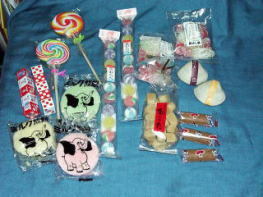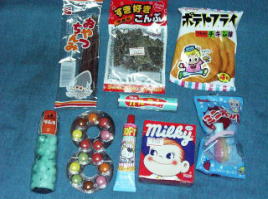
When I check Dagashi on dictionary and others. Dagashi is put into the
cheap sweets in English.
However, I think Dagashi 's meaning has just a little defferent nuance
to cheap sweets ..I feel this translation is not representative of Japan's Dagashi. Although Dagashi has low prise commonly ,its quality is fine and good.
.The quality is never poor. Dagashi are popular amoung the Japanese people and loved by people of all
ages.
Dagashi does not only mean " sweet and candish," but is also
the word for processed cuttlefish, shellfdish and other meat produkcts.
For many,Dagashi means not only great candies and snacks, but great youthful memories.
Dagashi meanings include several genre of Candys, Sweets, Snacks, Fruits, Vegitabules. . And It will give good memories of your yonug ages..
The following articles are apart of sentences written by Ms.Joseph Justice
about Funahashiya.
From 9 to 90, us kids love junk! Whatever form it takes, either collectible
or edible, one personfs trash is anotherfjoy and I, for one, would not want to
change that.
Funahashiya is a Kite,sweet,and rice
cracker shop on Teramachi the palate and the eye.The kites, decorated with dragons, carp,
and various heroes, usually samurai, are a visual delight. Tradition demands
that when a son is bornChis name be
written on the back of a kite Which the father then flies-just another excuse
to be a kidIOf courseCFunahashiyafs ownerCMrDTsujiCis still a
child at heartDHe not only
sells kites but makes his Own and on occasion teaches kite|makingDHe has several books forSale on the subject in the back of the
storeD
Although not related to the Childrenfs Day
holiday, many of the sweets Funahashiya sells are traditional, old-fashioned
ones. One drink that a 70 year-old friend of mine raves about is nikkisui,
cinnamon-flavored colored water, Historically important, Ifm sure, but I think
you had to have been there to really appreciate it.
Funahashiya also has light|Weight rollsCeither brown or red@iI recommend the brownjCthat are dried wheat|gluten saturated with brown sugarETheyfre called fugashi, and are really good with any kind of hot teaDAlso made of molded brown sugar are dolls and
traditional umbrellas on a stick. Still from ages past, but of Chinese origin
are deep-friend twists called karinto. If you break one into sma1l pieces and make a roll of it with
white sugar , itfs Called umebachi or hoten .
Before the days of sugar, a product called
mizu|ame was the standardDItfs made from rice and is very sticky and
moderately sweetDHard Candies
are made from thisCand some of
these lollipop|like things are
then coated with toasted soybean powderDCalled kinako-ame. they are quite tastyD Another tasty tooth|pullerino kiddingjis called
imo-ameDIt should be suckedDIt lloks like a potato and resembles the
traditional sweets that Ifve enjoyed in Korea.
Clewr and colored candiescxome in all sizes snd shapes. Roundish drops
of various flavors to suckers(remember all day suckers?) and tkhe multicolored
candies that I had at Chtistmas time in America abound.
--from Kyoto Visitorfs Guide May Vol.4 No10 1991

